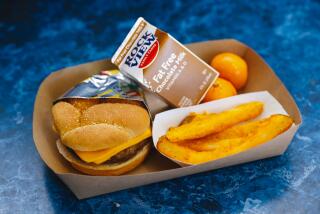Giving Kids a Leading Role in Nutrition
- Share via
This week we begin a new column on food and health written by Phil Lempert, a freelance journalist who specializes in food-related issues. The twice-monthly column will explore health and nutrition claims and provide tips for consumers to help them evaluate and select foods and beverages.
*
Remember mealtimes as a kid? Baby boomers grew up in an era of “new” foods: frozen meals, sugar-laden snacks and lots of preservatives. Moms urged kids to “clean your plate” under the threat of sending the food to hungry children in faraway lands if they did not.
Gen-Xers, in contrast, often were forced to make their own decisions at mealtimes. Many of them grew up as “latchkey” kids, in homes where parents were often away at work, and made their choices based on availability rather than nutrition.
Both generations’ food choices and habits are now being passed on to the kids of today--with alarming results.
The American Academy of Pediatrics estimates that one in four children under the age of 12 are overweight or obese; that’s an increase of 50% in the last 30 years.
Only about 1% of all obesity in children is caused by a hormonal problem or genetic disorder; the rest is due to a combination of bad diet, exercise and lifestyle habits.
Further, food is too often used both as a reward and as a way to keep noisy children quiet or busy--both at home and in the supermarket.
With childhood obesity increasing risks in adulthood of heart disease, diabetes, osteoarthritis and many other health problems, parents must stop unwittingly transferring poor eating habits to the next generation.
The easiest way to teach and learn about healthful eating (no matter how old you are) is in the supermarket. With an average of more than 27,000 products lining the shelves, it’s the perfect combination of schoolroom and laboratory.
However, don’t force a trip to the supermarket when you, or the kids, are hungry, cranky or tired--no one wins in that experience. And don’t attempt to put all of these ideas into practice on your next trip. Take “baby steps;” habits (yours especially) will not change overnight.
Fruits and Vegetables
The first stop in most supermarkets is the produce department, and it is a virtual, and healthful, playground for kids. They love the colors, aromas--and the nonlinear layouts. It’s a department that seems designed for kids.
Put them in charge of selecting a new fruit or vegetable on each shopping trip. Let them make their selection for whatever reasons they share--color, shape, strangeness, whatever.
Look for the produce manager, introduce yourself and your kids and ask the manager to teach your kids about that particular product.
Once home, have your kids help prepare the food, serve it and tell the rest of the family about the history, taste and health profile of that product.
Make produce part of everyday eating as well as using it as desserts in lunch boxes and for special occasions and treats.
Kids, like adults, want to be respected. Taking a few minutes to put them in charge of produce will put them in the mood to shop the rest of the store.
Informed Choices
Going up and down the aisles can be a nightmare for any parent, especially when it comes to those products that have been advertised to kids. (Aisles that have candies on one side and cereals on the other are especially frightful.)
The odds are against you. The makers of candies, sugar-laden cereals, and non-nutritive beverages spend billions of dollars to advertise to your kids. Their goal is to get their brand entrenched in your kids’ brains as early as they can. Your goal is to teach them the difference between products.
One of the most effective tools parents have is the nutritional label on every package in the store. Have kids take the product off the shelf and compare it, nutritionally speaking, to a more healthful alternative. Although they might not understand each nutrient’s value, going down the lists will teach them to read and compare.
For instance, when comparing breakfast cereals, first show kids the differences on the front of the packages. Get past the latest animated movie character, animal, captain or stone-age characters as quickly as you can. Explain the differences between the words on the front: “no added sugars,” “no preservatives,” “grown without GMOs” (genetically modified organisms) and compare them with the marketing messages that may appear more prominently.
Next, review the nutritional panels together. Compare calories and fat, but don’t forget the fiber, calcium, vitamins and, most important, the sugars. Explain that sometimes more is better (like calcium and fiber), and at other times, less is better (calories, fat and sugars). Look at the ingredient statement and show your kids the raw ingredients.
Being visual with kids is more important than the words. If they think the food looks good, they’ll eat it; so it is important to make them part of the process of buying and preparing.
Learning Through Doing
Kids love to cook or, more accurately, play, in the kitchen. Have them help you make healthier foods. For example, pass on the prepackaged rice mixtures and have them help you select veggies and spices to make your own. When cooking, ask them what a particular ingredient’s effect will have on the food; if they don’t know, tell them--you’ll be surprised just how much they’ll remember.
On different shopping trips, introduce them to the meat, seafood, bakery and deli managers. These employees often love teaching and sharing knowledge. Ask them to explain the differences between raw materials and preparation techniques. Show your own interest as well; your kids will look to your attention as a model for their behavior. (Include “food safety” in these discussions, using the label on all meat and poultry packages as a guide.) Be considerate and use these “food professors” in off-peak shopping times--they will give your kids [and you] a higher-quality education.
Spend time with your kids finding nutritious substitutes for less-healthful foods that taste good. Instead of frozen sugary ice pops, take fresh watermelon, blend into a slush, and freeze. Choose cookies and cakes that have less sugar or that are sweetened with fruit juices. Do your own family “taste tests” to choose which products are best.
Nutrition is a new science, and right around the corner is a new generation of foods that are more healthful, designed to cure disease, easier to prepare and better tasting. Teaching your kids how to select their foods and read labels will give them the tools they need to eat a healthier diet. Teaching them that the supermarket experience is a positive one is critical.
Most important, be sure they become a partner with you in the foods they eat; let them experiment and try new healthful combinations. Laurie, a parent of three (ages 9, 6 and 2) shared with me her kids’ all-vegetarian recipe for a peanut butter and spaghetti omelet they often make and eat together. It’s one of those foods she has learned to love.
*
Phil Lempert hosts a nationally syndicated radio show and is the food correspondent for NBC’s “Today.” He can be reached by e-mail at PL[email protected]. His column runs the first and third Mondays of the month.
More to Read
Eat your way across L.A.
Get our weekly Tasting Notes newsletter for reviews, news and more.
You may occasionally receive promotional content from the Los Angeles Times.









